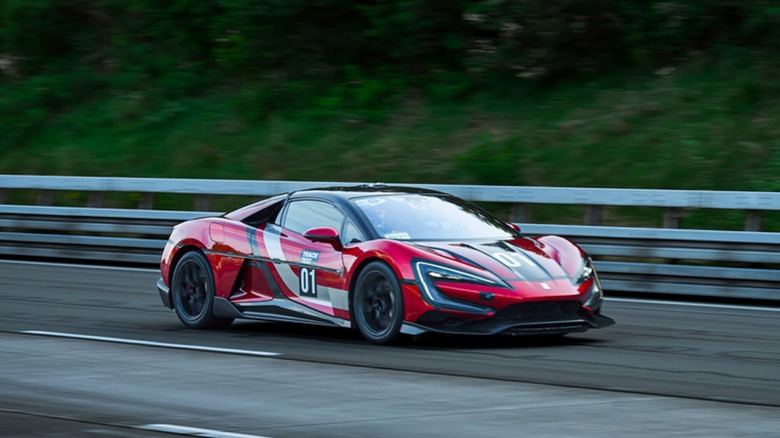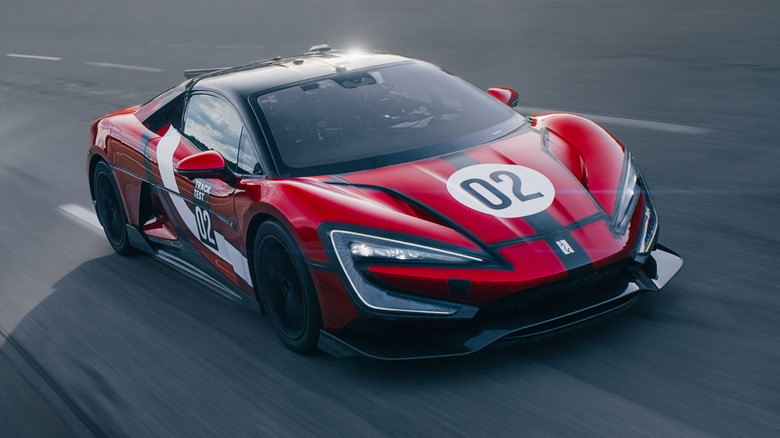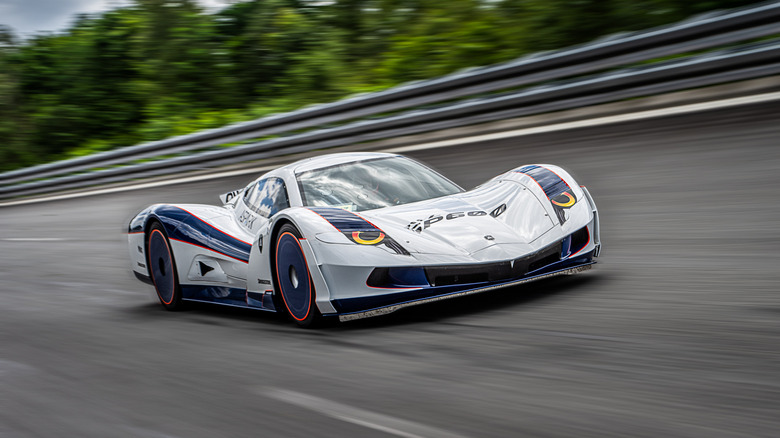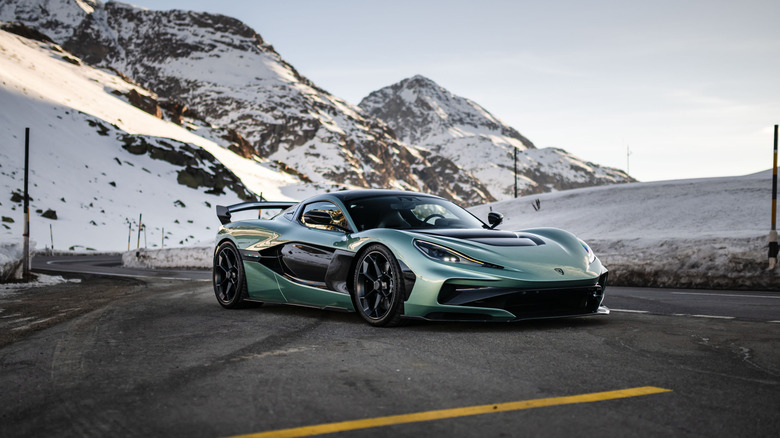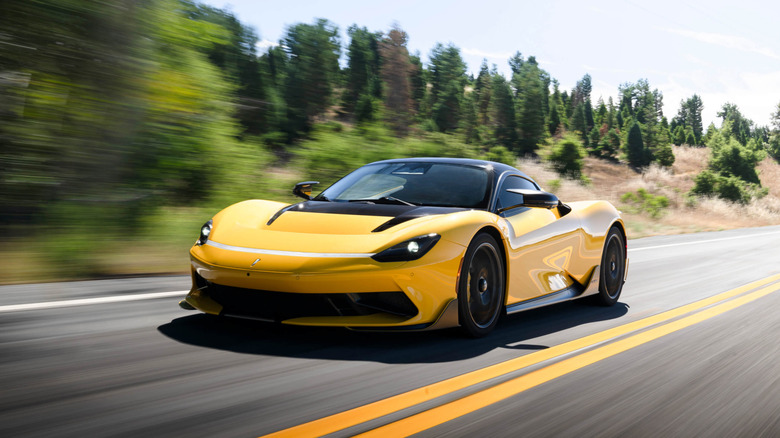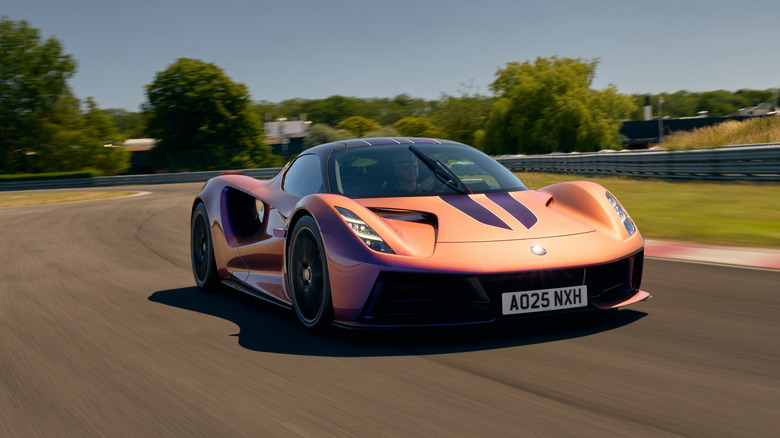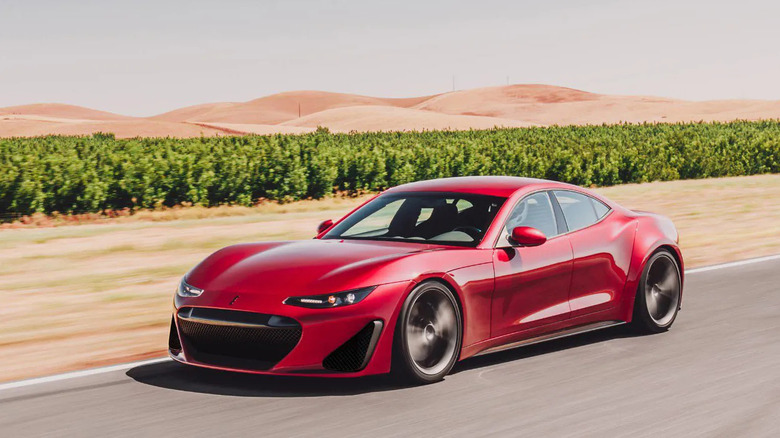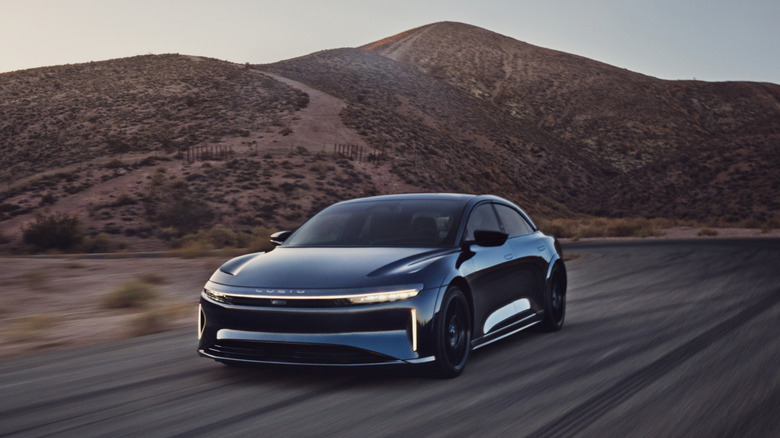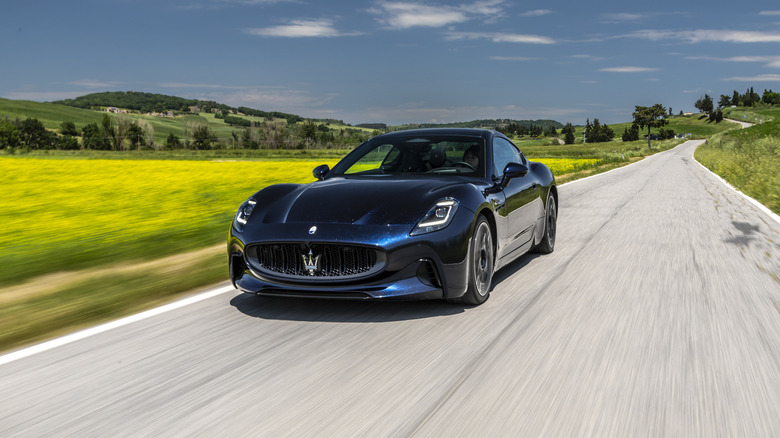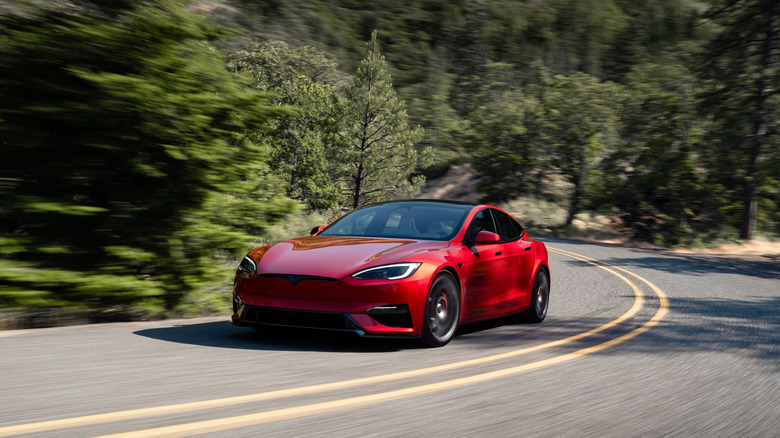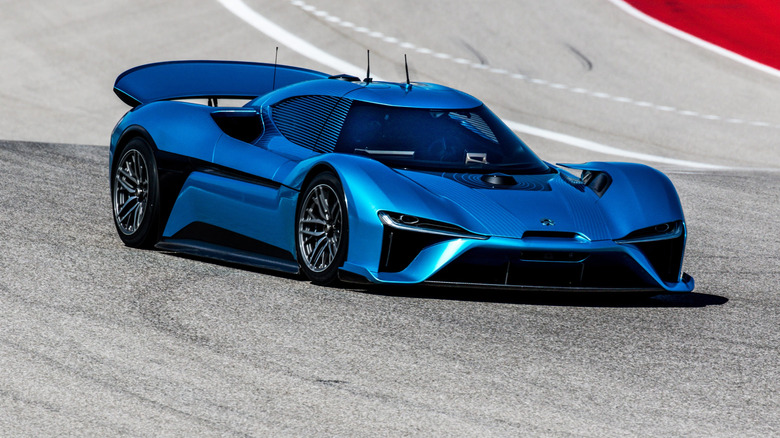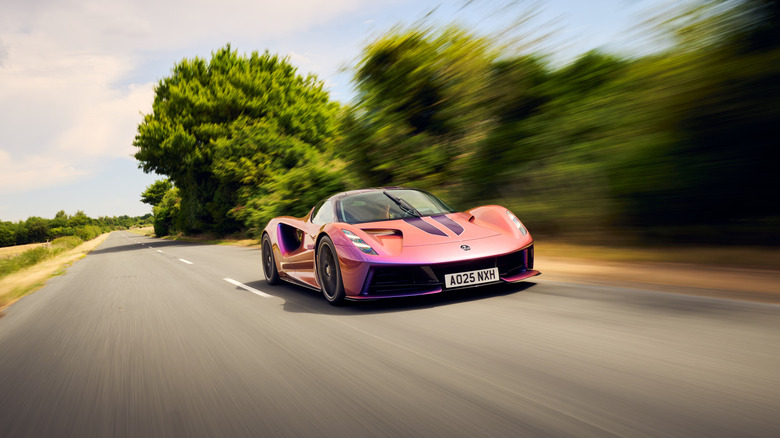10 Of The Fastest Electric Vehicles In The World, Ranked By Top Speed
When electric vehicles first came around, they had a lot of problems. They looked ugly, couldn't cover long distances, and most importantly, lacked speed and power. This made them unappealing to both enthusiasts and the common person. After all, nobody wants to buy a car that gets them stereotyped into a particular category. Fortunately, with each passing year, EVs have become better, faster, and everyone has taken notice of the instant power and torque available with such powertrains.
Gone are the days when a 1,000-horsepower engine was reserved for multi-million-dollar hypercars like the Bugatti Veyron Super Sport or the Koenigsegg Agera RS. In 2025, a new group of electric sports car brands, including Rimac, BYD, and Aspark, is pushing the boundaries of physics to create not only the quickest electric supercar but possibly the fastest cars ever built. Here's a list of ten of the fastest electric production cars in the world, ranked by top speed.
1. BYD Yangwang U9 Extreme - 308 mph
The Bugatti Chiron Super Sport 300+ long held the title of fastest production car on the planet. For most other car brands, this record was simply impossible to beat. But on September 14, 2025, there was a disturbance in the force. That's because the BYD Yangwang U9 Extreme dethroned the Bugatti Chiron to become the fastest production car ever, clocking a speed of 308.4 mph at the ATP test site in Papenburg, Germany.
For those unfamiliar, BYD is a Chinese automaker that began producing batteries in 1995. The company entered the car market with the BYD F3 in 2003, and its early years weren't particularly successful. Its cars resembled copies of Western alternatives, and nobody knew them outside of China. However, the car maker steadily addressed the complaints and slowly expanded to markets like Brazil and Australia, where its value-for-money proposition became a hit.
The BYD Yangwang U9 Extreme is the pinnacle of what this Chinese automaker has to offer. The car builds on its U9 sibling and produces an eye-watering 3,000 horsepower from its four electric motors. This insane performance is thanks to the all-new 1,200V ultra-high voltage platform, which can deliver 1,000 amps of current.
The U9 Extreme also rearranges the battery into a blade-like structure and incorporates BYD's new lithium-iron-phosphate battery chemistry, which provides higher energy density. The suspension can apply 9 kW of bidirectional pressure on each tire, essentially giving the Yangwang U9 Extreme the ability to bunny hop over the potholes detected by its sensors. BYD will only build 30 units of the Yangwang U9 Extreme, and each would cost 1.68 million yuan (around $236,000).
2. Aspark Owl SP600 - 273 mph
The Japanese company Aspark was founded in 2005, not as a carmaker, but as an engineering services provider to other companies. However, in 2015, there was a radical change in the company's direction as it set its eyes on making an all-new electric hypercar. The first prototype of the Aspark Owl SP600 was unveiled to the public at the 2017 Frankfurt Motor Show.
Making a production version in Japan proved quite the challenge. This resulted in Aspark collaborating with Italian car design and manufacturing firm Manifattura Automobili Torino to build the car. And the result broke all records. That's because the Aspark Owl SP600 is powered by four motors that combine to produce 1,953 horsepower and 1,416 lb-ft of torque. This power was enough to take the car from 0 to 60 mph in 1.72 seconds and claim an estimated top speed of 256 mph.
These numbers soon proved to be inaccurate when a production version of the SP600 achieved 273 mph in the hands of racing driver Marc Basseng at the ATP test site in Papenburg, Germany. The hypercar is built with a super-light carbon fiber chassis and weighs just 4,519 pounds. Plus, the battery provides a respectable 250 miles of range. Aspark plans to produce only 50 versions of the SP600, and each costs $3.5 million.
3. Rimac Nevera R - 267 mph
In 2007, when electric cars were nothing but a laughing stock among enthusiasts, a Croatian named Mate Rimac started working on a project to convert his old BMW 3 Series into an EV. Along the way, he founded Rimac Automobiles, and in 2011, his new electric e-M3 broke five world records on a runway near Zagreb.
Rimac essentially started the electric hypercar genre and previewed the Nevera as the Concept_Two at the 2018 Geneva Motor Show. The Nevera R is the track-focused version, which can go from a standstill to 60 mph in just 1.66 seconds and has a top speed of 267 mph. But that's not all, as it can also cover the quarter mile in just 7.9 seconds. For context, the Bugatti Chiron Super Sport takes more than a full second longer to do the same.
All this performance is thanks to the quad motors, which produce 2,107 horsepower and 1,725 lb-ft of torque while providing the Nevera R with four-wheel drive. Even Jeremy Clarkson, after testing the Rimac Concept One, said he hadn't seen something get off the line as quickly as that car, categorizing it, in a word, "billiant". The Nevera R is highly aerodynamic and can travel an EPA-estimated 204 miles on its 108 kWh battery. Rimac plans to produce only 40 units of the Nevera R, and each costs $2.5 million.
4. Pininfarina Battista - 222 mph
Back in the 1930s, when a car's chassis and body were completely separate components and buyers had the choice to create any body they wanted, the Italian luxury coachbuilding firm Pininfarina was a huge name. It even collaborated with brands like Ferrari to design hundreds of models, including icons such as the Testarossa and the Ferrari 250 GT series. However, as safety standards for cars became increasingly demanding and the body became integrated into the chassis, coachbuilding became obsolete, and the company suffered.
In 2015, Mahindra, an Indian car manufacturer, acquired Pininfarina with a straightforward goal. To get the brand back to its glory days, and make the first all-electric hypercar that pays homage to its founder, Battista "Pinin" Farina. The result was something exquisite.
The Pininfarina Battista shares the same drivetrain and carbon tub as the Nevera. And not only does the Battista look gorgeous, but it's also astoundingly fast, capable of reaching 222 mph thanks to its quad motors, which produce 1,900 horsepower and 1,726 lb-ft of torque. In 2023, it even set the fastest quarter-mile time for a production car at just 8.55 seconds. While this record has since been broken, the Battista remains one of the fastest EVs today. With its 120 kWh battery, it can travel up to 310 miles on a charge. Only 150 units of the Battista will be built, with prices starting from $2.6 million.
5. Lotus Evija - 219 mph
The Lotus Evija is one of the few electric hypercars from a legacy car maker on this list. The Evija was announced to the world in 2019, but Covid-19 delayed its launch until last year. Each unit is hand-built and features a carbon monocoque chassis, which results in a car weighing just 4,176 pounds. This weight, coupled with the quad electric motors that produce over 1900 horsepower and 1,254 lb-ft of torque, makes the Evija a track monster.
It can accelerate from 0 to 60 mph in under 3 seconds and has an electronically limited top speed of 219 mph. To keep the Evija on the ground, Lotus has designed Venturi tunnels that direct air underneath the chassis to create a low-pressure zone, essentially sticking the car to the pavement. The 91 kWh battery pack is mounted behind the driver's seat to mimic the handling of a mid-engined sports car. The Evija can travel roughly 195 miles on a single charge and costs around $2.3 million (excluding taxes).
6. Drako GTE - 206 mph
Drako Motors is an American carmaker founded in 2013 with the goal of making luxury electric sports cars. In 2019, the company introduced the GTE, which borrowed the body and chassis of the Fisker Karma Revero GT, but ditched the hybrid drivetrain, transforming it into one of the fastest electric cars capable of reaching 206 mph. This performance can be attributed to the four magnet hybrid synchronous motors, which combine to produce 1,200 horsepower and 6,491 lb-ft of total wheel torque. Each of the four motors is also connected with a high-capacity inverter that helps the GTE endure track day sessions.
The Drako GTE features a new 90 kWh battery that provides 1,800 amps of continuous energy or 2,200 amps of peak power. In terms of range, it can travel up to 250 miles before needing a recharge. There are only 25 GTEs in the world, with each costing at least $1.3 million.
7. Lucid Air Sapphire - 205 mph
Lucid was founded in 2007 by former Tesla executives, initially focusing on developing powertrains and battery technology for other brands, as well as for racing series, such as Formula E. In 2016, however, the brand transitioned to producing EVs for the consumer market, and the Lucid Air Sapphire is the best it has to offer. It competes directly with the likes of the Tesla Model S Plaid, and while it may look like another harmless electric family sedan, there's a devil inside.
Underneath the luxurious aesthetic lie three electric motors, producing a total of 1,234 horsepower and 1,430 lb-ft of torque. These motors can accelerate the car from 0 to 60 mph in just 1.89 seconds and to a top speed of 205 mph. Despite its ludicrous performance, the Sapphire also has four doors, can seat a family, and travel 427 miles on a single charge. While Lucid hasn't specified how many Sapphires will be built, each one costs $250,000.
8. Maserati GranTurismo Folgore - 202 mph
Italian car maker Maserati needs no introduction. The brand has been around since 1914 and has made some of the most iconic cars the world has ever seen. Maserati has always been associated with powerful (internal combustion) engines. So, when the company announced plans to create an electric sports car and its return to a racing series, specifically Formula E, fans had their concerns.
Folgore, the Italian word for "lightning," is Maserati's electric subdivision. The GranTurismo Folgore is the company's first attempt at an electric vehicle, and it gets many things right. The 2026 edition is powered by three motors that combine to produce 818 horsepower and 995 lb-ft of torque. And it's seriously quick, capable of reaching 60 mph from a standstill in just 2.7 seconds and achieving a top speed of 202 mph.
The GranTurismo Folgore also benefits from Maserati's racing legacy, with experts complimenting the car's handling and cornering ability. The 83 kWh battery enables the car to travel up to 240 miles on a single charge. Plus, it supports 270 kW of fast charging, which adds 60 miles of range in just 5 minutes. While the number of units being produced is unknown, prices for the GranTurismo Folgore start at $199,690.
9. Tesla Model S Plaid - 200 mph
It's no secret that Tesla is the brand that brought electric vehicles to the mainstream and made them a genuine alternative to gas cars. Without models like the Tesla Model Y, which sold in the millions, the electric future would still have been a distant dream. The Model S Plaid is the company's top-of-the-line offering. It debuted in 2021 and made all the headlines.
That's because for just $89,990, the Model S Plaid comes with three electric motors that combine to provide a staggering 1,020 horsepower and 1,050 lb-ft of torque. These motors enable the car to accelerate from 0 to 60 mph in just 1.98 seconds on a prepped raceway and attain a top speed of 200 mph. Besides its insane performance, the Model S Plaid is also a competent family sedan, capable of carrying four people for a picnic or going on weekly grocery shopping, and features a ton of useful amenities, including Smart Summon. There's also a 100 kWh battery underneath the floor, which provides around 368 miles of range.
10. Nio EP9 - 194 mph
Announced back in 2016, the Nio EP9 was China's answer to the Rimac Concept One, and for the most part, it won. It's still one of the fastest electric cars in the world, and for good reason. The four electric motors that power the EP9 produce 1,341 horsepower and 1,091 lb-ft of torque, enabling it to accelerate from 0 to 60 mph in 2.7 seconds and reach a top speed of 194 mph.
But that's not all. The EP9 is a track demon, thanks to the active aero and channels underneath the car, which direct the airflow for maximum downforce. It even set a Nürburgring lap record for EVs with a time of 6:45.9. Unfortunately, the EP9 wasn't designed to be road legal. So, if you do buy one of the six units, Nio will deliver the EP9 to your favourite track, where you can thrash it around. And once the day is over, the company will take it back. An EP9 today can cost around $1.2 million.
Methodology
For this list, we picked the cars based on specific requirements. For an EV to be considered, it must be a production version, not a concept. It also had to be tested by media outlets or racing drivers. We do not rely on company-quoted top speed figures for prototypes, as they can be inaccurate. Instead, we have verified the numbers through a list of reliable sources.
This is the reason why cars like the Tesla Roadster or the Deus Vayanne were excluded. Tesla has been promising to deliver the Roadster to people for half a decade without a sign. On the other hand, the Deus Vayanne is set to go into production this year.
